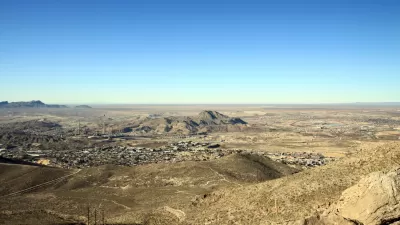The George W. Bush Presidential Center, which was dedicated this past week, is a rare glimpse into the former president’s understanding of his own legacy, writes Henry Grabar.
The building, which sits on the Georgian revival-dominated campus of Southern Methodist University, was designed by architect Robert A. M. Stern. “I wanted it to have the Texas feel that this building does because that’s where we’re from,” Laura Bush explained. The building was constructed largely of local materials, including Texas Cordova Cream limestone and mesquite floors.
“I also wanted the building to be modern-looking, to be forward-looking because George was president during the very first decade of our new century,” the former first lady explained. But while the LEED Platinum-certified structure may be on the cutting edge of sustainable design, its architecture is hardly avant garde. Its rectilinearity recalls 1930s Italian architecture and nineteenth-century New England mill towns. Other precedents include the Temple of Queen Hatshepsut and Karl Friedrich Schiller’s Schauspielhaus.
In his design for the presidential library, Stern succeeded in capturing some of the contradictions at the heart of George W. Bush’s self-image: compassion and conservatism, warmth and firmness.
FULL STORY: An Architectural Reflection of George W. Bush

Americans May Be Stuck — But Why?
Americans are moving a lot less than they once did, and that is a problem. While Yoni Applebaum, in his highly-publicized article Stuck, gets the reasons badly wrong, it's still important to ask: why are we moving so much less than before?

Using Old Oil and Gas Wells for Green Energy Storage
Penn State researchers have found that repurposing abandoned oil and gas wells for geothermal-assisted compressed-air energy storage can boost efficiency, reduce environmental risks, and support clean energy and job transitions.

Placekeeping: Setting a New Precedent for City Planners
How a preservation-based approach to redevelopment and urban design can prevent displacement and honor legacy communities.

A Year-Long Investigation On Permanent Supportive Housing
The New York Times reveals what’s working and what’s not in the cornerstone of Housing First.

Survey: US Public Spaces Not Meeting Community Needs
A lack of funding prevents many U.S. parks and public spaces from playing a more significant role in helping residents meet daily needs.

San Francisco’s Muni Ridership Grew in 2024
The system saw its highest ridership since before the Covid-19 pandemic, but faces a severe budget shortage in the coming year.
Urban Design for Planners 1: Software Tools
This six-course series explores essential urban design concepts using open source software and equips planners with the tools they need to participate fully in the urban design process.
Planning for Universal Design
Learn the tools for implementing Universal Design in planning regulations.
Heyer Gruel & Associates PA
City of Moreno Valley
Institute for Housing and Urban Development Studies (IHS)
City of Grandview
Harvard GSD Executive Education
Salt Lake City
NYU Wagner Graduate School of Public Service
City of Cambridge, Maryland




























